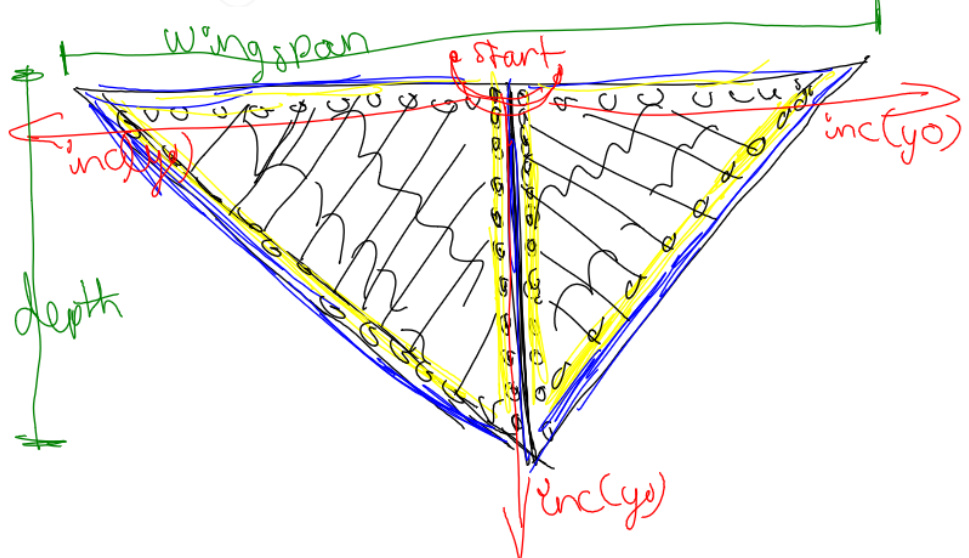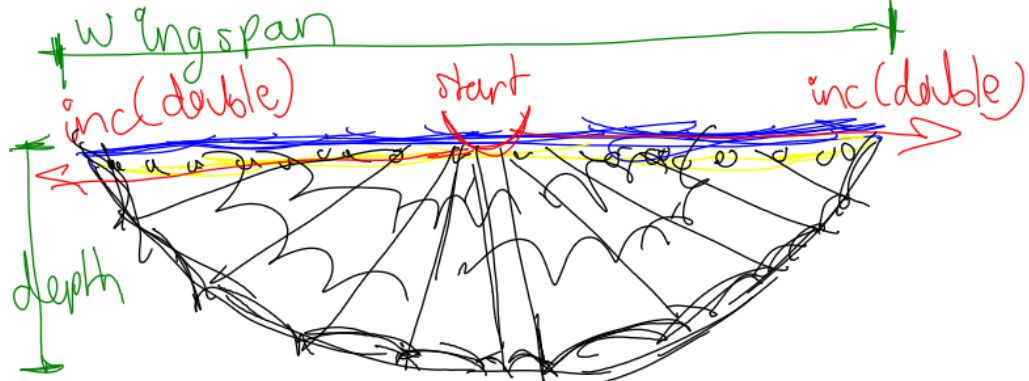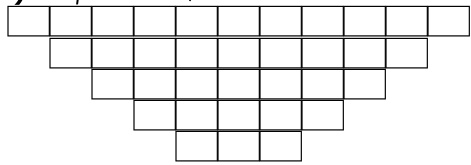Corinthian Order MKAL by DeviousRose
Corinthian Order is a lace shawl/stole inspired by Greek architecture. This is the stole/rectangular file. If you want ALL the shapes or the triangular or crescent, please download the master file or that respective shape's pdf file. Happy yarning!

Table of contents:
Prologue: Yardage, bead counts, design choices, and some basics on shawl structure...Page 1 Clue 1: Chart key & special abbreviations, main body chart (Colour A if 2 colours)...Page 3 (midway) Pillar Lace chart...Page 4 Abbreviations...Page4-5 Clue 2: Border transition chart (Colour B hereon and after if two colours)...Page 5 Clue 3: Border chart, cast off, and blocking information...Page 5 (midway, after Clue 2) Casting off & blocking info...Page 6 Size: 80 cm x 62 cm/31.5 in x 24.5 in, but customizable with more or less repeats of the main chart. Stole or scarf have directions for 55 inches-60 inch length, depending on your gauge and blocking.
Materials:
- 550-700 yd/458-550 m light fingering weight or fingering yarn. If doing 2-colour, you will need about 450 yards of Colour A and 200 of Colour B. I used \~400 yds for the triangular in worsted. - 4 mm/Us 6 circular needles (or size to obtain a lacy, open, flexible fabric) - Beads: 6/0 seed beads, 5 per pattern repeat plus \~110-120, but you can substitute with a nupp. The amount of beads will vary depending on your repeats- for a light fingering weight shawl I used 240 beads. - 2 stitch markers recommended to mark either side of the spine on the triangular version
Main body:
- stockinette full body lace
Colours:
- one colour- the splendour of ancient Greece after its heyday - two colour- speculate the colouration the ancient Greeks may have used. Best with the full lace option. http://www.ravelry.com/designers/deviousrose Corinthian Order, @DeviousRose
Basic shawl crash course:
http://www.ravelry.com/designers/deviousrose
Shawl terminology:
uepi- ieiyili ui Ilie sluwi ui iis ueepesi pullli edge/border/selvedge stitches- 2 or 3 garter stitches worked on the outer edges of the shawl to create a smooth line on the outside of the shawl. garter tab cast-on- creates α smoother edge than casting on the beginning stitches and knitting 2 rows before set up. A more detailed explanation will be available in Clue 2 wingspan- width across the top of the shawl
Shaping:
Triangular shawls grow via increases at their edges and centers. It has a spine at its center, most often a singestitch garter ridge or single-stitch line of stockinette. I have made the shawl spine for this design a two-stich, basic cable instead of a single-stitch ridge.

Figure 1: Structure of a triangular shawl, with colouration following that of Figure 3a. The blue edges indicate the border stitches. Circles indicate yarn overs. Crescent-shaped shawls grow out on either edge by two stitches. This means that depth will build up more slowly than in a triangular shawl, and the slope gives the impression of a crescent. Crescent shawls are sometimes worked bottom-up. Their wingspan is wider than triangular shawls in proportion to their depth, which is shallower when compared.

Figure 2: Structure of a top-down crescent shawl, as this pattern will use. The edge increases are always some form of double increase, so the shawl does not grow out towards the bottom, as a triangular shawl does.
Corinthian Order, @DeviousRose
Reading a chart:
Shawls are often written in only or mostly charts. I have written directions in the pattern, but charts let you know where your stitches line up in relationship to on another and your overall pattern. Charts in this pattern will be RS (right side) only, and for the triangular charts will be worked twice on each side of the spine. I will include edge increases, but many patterns do not.

Figure 3a (above): Typical chart (with increases and spine shown) for a triangular shawl, with RS only shown. Figure 3b (below): In patterns, these will often be shown as:

Crescent charts increase by two on either side:

Figure 4 (above): Typical chart (increases NOT shown) for a crescent-shaped shawl, RS only. It is worked once, and the shawl increases by 2 stitches on each side.
Clue 1: Building the temple foundation & columns
Special Abbreviations:
btc- back twist cable (k tbl into 2nd st from needle, k into first st of needle normally, slip both worked sts onto workingneedle) cdc- centered double decrease (sl 2 kw, as if to k2tog, k next st, p2sso) For other abbreviations, scroll to the bottom of the document and see "Abbreviations." For chart symbols, see the chart key on page 5.
Chart information:
- The stitch repeat for each chart is 12 stitches. A single Chart 1 repeat is about as long as the border repeat. -ws (odd) rows are NOT shown on any of the charts. These are simply purled across. -Border stitches (the k2 on either side) and edge increases are also NoT shown on the charts. - Note that one of the double decreases is a slk2tog psso (slip next st kw, k2tog, pssso).
Rectangular (stole/scarf):
Directions are written as scarf (stole). As with the other shape options, the chart omits the k2 on either side. CO 41 (65), or any multiple of 12+5 (chart + selvedge stitches) using a provisional cast on, so you can pick up and knit later to make both scarf halves symmetrical- and omit grafting. Work 36 in/92 cm in stockinette stitch. Pick up and knit as many stitches as you cast on from the cast on side, and begin to work each set of directions identically on both sides. Corinthian Order, DeviousRose Work Chart 1 twice, then work Rows 2-39 (Rowss 2-38 of chart, then work a wS row). work chart rows with each row ask2,chart,k2! For an alllace scarf (stole), work a few rows of Chart 1, then pick up the stitches from your provisional CO. work the first chart row for the other half, but instead of doing the cdc as written, slip 2 sts knitwise, return to left needle, and k3tog. work a ws row and then continue chart as written. Stockinette version: cast on likewise, but knit in stockinette until 8 inches/20.5 cm less than desired.
| Chart key (abbreviations on last page) | ||
| stockinette(knitonRS,purlonws) | M1 | |
| yo | btc | |
| k2tog | garterstitch | |
| ssk | pattrepeat | |
| no stitch | stitchcounts | |
| cdc | spine sts | |
| s1k2tog psso (sl 1 kw, k2tog, psso) | no stitch | |
| M1,yo | yo, M1 on right half of chart, on LEFT half of chart | edgeincrease |
| B pb (placebead | and slip stitch without working | knitonwSandRS |
Pilar Lace (Chart 1 Rectangular) (multiple of 12+1)
| O | ||||||||||||||||||||||||||||||
| o00 | ||||||||||||||||||||||||||||||
| o00 | ||||||||||||||||||||||||||||||
| O | O | |||||||||||||||||||||||||||||
| O | 0000000000000000000o | |||||||||||||||||||||||||||||
| o | O | |||||||||||||||||||||||||||||
| 0000000000000 | ||||||||||||||||||||||||||||||
| 00000 | ||||||||||||||||||||||||||||||
| 12 | o o O O 0 | O | 13 | 1 | 乙988℃ | |||||||||||||||||||||||||
| 0000000 o 0000 |
Abbreviations:
CCW counterclockwise cdc centered double decrease (sl 2 kw, as if to k2tog, k next st, p2sso) cast on or cast off, depending on context CW clockwise k knit k2tog knit 2 together kw knitwise m1 make 1 (pick up bar between sts from previous row and knit) p purl pb place bead (after sliding bead onto stitch, DO NOT work stitch, but simple slip and continue to follow the chart) p2sso pass 2 slipped sts over psso pass slipped stitch over pw purlwise RS right side s1k2tog psso sometimes abbreviated as ssk in other patterns- slip 1 st kw, k2tog, psso (lleff-leaning double decrease) sl slip sm slip marker ssk slip, slip, knit (sl st kw, next st, psso) st(s) stitch(es) tbl through back loop WS wrong side yo yarn over
Clue 2: Preparing the pillars for embellishment
Now, we use beaaaads! Remember, you can replace beads with nupps if you want, but it will have a different effect and nupps are yardage devourers.

Clue 3: Finishing & consecrating (blocking) the temple
The triangular and crescent charts have been split in half for your viewing and printing convenience. It was designing this and seeing everyone's progress and takes on the project! Thanks to this, I now completely understand why designers sometimes release several updates of one pattern in the same day, and I have a deeper appreciation for designers who host CALs and KALs, especially mystery ones. I hope everyone had as much fun as I did, despite the errors that riddled the clue releases!

Casting off (all versions):
K1, \*k1, insert stitch-holding needle(left for right-handed people) into the front of the two stitches on the working (right) needle and k tog through front loop, similar to an sk\*, repeat from \* to \* to cast off all sts. ff and block. I usually weave in ends after blocking, but you can do it before Corinthian Order, @DeviousRose
Blocking a lace shawl:
After casting off, your shawl will look crumpled and not very lacy at all, so if you don't block or don't often block, you will have to block your lacework. There is an easy way, without too many pins and no blocking wires, and a hard way to do this. The hard way is to get all your pins and stab through each point, curve, edge, and whatnot to get the shawl into shape. This is fine for patterns with simple edges, but annoying for scalloped, petaled, or any other complex edge motif, such as the points and spires of this design. If your design is complex, it is maddening to get all. Those. Edges. Perfectly in place. Not to mention getting that spine and the top of the shawl to behave! The easy way requires waste yarn for the top edge and the cast off edge (essentially, the whole perimeter), and pins just for the points. A similar method to mine, can be found at http://www.yarnharlot.ca/blog/archives/2005/08/23/walk_around_the_block.html with pictures! You need 2 or 3 lengths of waste yarn: one for the top edge of the shawl, at least 20 cm/8 inches longer than your intended wingspan (top dimension), and one length 20 cm/8 inches than the lower outer length around the body of the shawl, or 2 lengths each 20 cm/8 inches longer than the lower outer length of each body half of the shawl. You thread the first string through the top of the shawl, either through the yarn overs or the edge stitches, and the second string through the bottom CO edge. If you have three lengths of string, repeat the motion for the second on the other half of the body with the third string. Now you go about the same way you block any item: wet the item according to the yarn you are using, such as total water immersion for strong materials like merino or other sheep wools, and THEN pinning into shape, or pinning into shape and THEN spritzing until slightly damp for fibers like alpaca or cashmere. Now, don't panic. The "pinning into shape" here isn't the hard way described in the first paragraph. Here, you simply stab two pins through your blocking surface as far apart plus wiggle room as you want your shawl to have a wingspan, and wrap each edge of the top string each of the pins. Now you pull out the center of the shawl to how deep you want it, and pin through where the second string is (or second string and third string). Pin out each scallop. corner, or whatever the shaping is for the edge, and the waste yarns willforce the cast off edge to follow the slopes of your lace. For this shawl, you will pull the points of the column tops out to cause them to flare. Whether you gently mist after pinning, or immerse in water before blocking, is up to you and the sort of yarn you'veused.
Pattern support:
If you catch a mistake on the charts or such, PLEASE let me know through Ravelry pm! For troubleshooting the pattern or style options, browse through the original MKAL forum on Ravelry to see people's questions and mods. If you have any other questions or concerns regarding the pattern, feel free to send me a message on Ravelry. You could also e-mail me at deviousrose@hotmail.com, but I do not check that email as often as I should, whereas I am addicted to Ravelry. As a little side note, I would once again like to thank everyone who knit this up during the MKAL, whether active forum posters or not, or on time or not, but I would especially like to thank those who reported your progress and asked questions. Without you, I would not have been able to release corrections and may not have noticed mistakes or confusing directions for a very long time. This MKAL would not have been successful withoutyou! Happy yarning! Au revoir!









